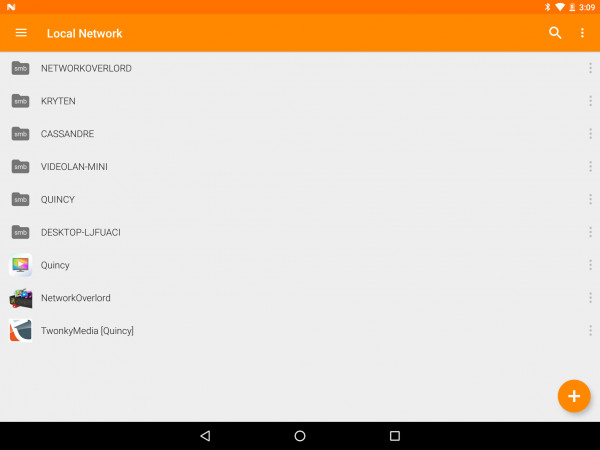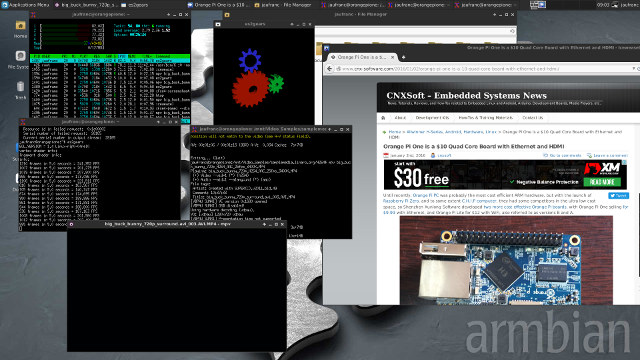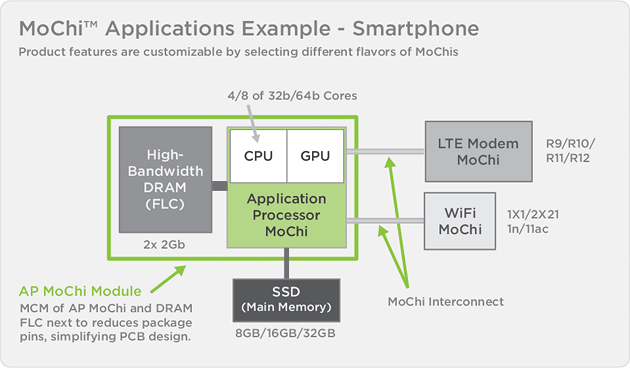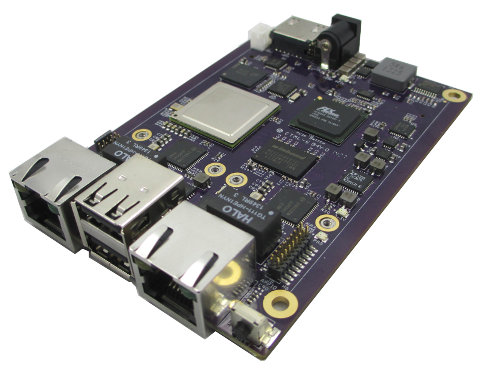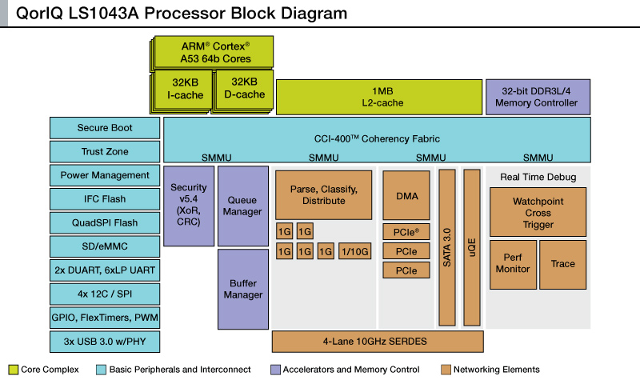VLC / VideoLAN is a popular desktop video player for Linux and Windows, and it’s the program I go to when I want to watch a local video on my computer. VLC also has an Android version, but last time I checked VLC in an Android TV box, I was disappointed due to the lack of SAMBA support, and video decoding support was pretty poor on Rockchip RK3368 processor at the time. The good news is that the developers have now released VLC for Android 2.0, which brings several improvements including: Support for network browsing including DLNA/UPnP, Windows Shares (SAMBA), FTP(S), SFTP, and NFS Multi-windows/pop-up video with support for Samsung MultiWindow and LG Dual Window extensions New asynchronous hardware decoder, and codecs and formats support updates. Subtitle downloads via OpenSubtitles from VLC interface without having to go to the website inside a web browser Right-To-Left and Complex Text Layout subtitles […]
Accelerated 3D Graphics, Hardware Video Decoding, and Network Performance on Orange Pi One Board (Video)
I’ve just written Getting Started Guide for Orange Pi One, a $10 development board based on Allwinner H3 quad core Cortex A7 processor, where I explain how to install and configure Armbian distribution on the board. As promised, I’ve also tested 3D graphics acceleration, and hardware video decoding, and also included some Ethernet benchmarks. Since ARM Mali-400 GPU found in Allwinner H3 is only capable of OpenGL ES, as in most ARM SoCs, you can test 3D graphics acceleration by using es2gears (and not glxgears as I’ve seen some other do in the past):
|
1 2 3 4 5 6 |
es2gears EGL_VERSION = 1.4 Linux-r3p0-04rel0 vertex shader info: fragment shader info: info: 1463 frames in 5.0 seconds = 292.425 FPS |
The log shows the utility is using Linux-r3p0 Mali driver, and the gears are display at a high frame rate close to 300 fps. If I switch to full screen, the frame rate drops to about 43 fps, which should still be acceptable. CedarX is the infamous closed source and GPL violating media library released […]
Linux 4.3 Release – Main Changes, ARM and MIPS Architectures
Linus Torvalds released Linux Kernel 4.3 last week-end: So it *felt* like the last week of the rc series was busy, to the point where I got a bit worried about the release. But doing the actual numbers shows that that really was just my subjective feeling, probably due to the kernel summit and travel back home from Korea. It wasn’t actually a particularly busy week, it’s just that the pull requests were more noticeable in the last couple of days. We had a network update and a late fix for a x86 vm86 mode bug introduced by the vm86 cleanups, but other than that it’s just a collection of various small one-liners all over. Ok, the vm86 mode thing was a one-liner too, it was just slightly more nerve-wracking because it looked scarier than it was before people (Andy) figured out what was going on. The changes from rc7 […]
Marvell Announces AP806 Cortex A72 & ARMADA A3700 Cortex A53 Virtual SoCs based on MoChi & FLC Architecture
Marvell has published a press release introducing AP806 quad core Cortex A72 and ARMADA A3700 dual and single core Cortex-A53 chips. But these two chips are called Virtual SoCs (VSoC) and they are said to use MoChi and FLC (Final Level-Cache) architecture. What does this all means? If I understand correctly, Marvell has decided to create modular SoCs that may just integrate the minimum: CPU, GPU, and memory controller, with other peripherals like Ethernet, SATA, LTE Modem added to the virtual SoC in some ways just like legos. This is done in order to mitigate the cost of manufacturing chips with advanced process nodes (e.g. Finfet 16) with usually has high steep mask costs, and wafer prices. So they may have a single AP806 MoChi module, to create multiple SoCs using different MoChi modules to add peripherals. Marvell listed some of the key befinits of modular SoCs: Changing existing software […]
Linux 3.19 Release – Main Changes, ARM and MIPS Architectures
Linus Torvalds released Linux Kernel 3.19 yesterday: So nothing all that exciting happened, and while I was tempted a couple of times to do an rc8, there really wasn’t any reason for it. Just as an example, Sasha Levin used KASan and found an interesting bug in paravirtualized spinlocks, but realistically it’s been around forever, and it’s not even clear that it can really ever trigger in practice. We’ll get it fixed, and mark it for stable, and tempting as it was, it wasn’t really a reason to delay 3.19. And the actual fixes that went in (see appended shortlog) were all fairly small, with the exception of some medium-sized infiniband changes that were all reverting code that just wasn’t ready. So it’s out there – go and get it. And as a result, the merge window for 3.20 is obviously also now open. Linus Linux 3.18 improved performance of […]
Gateworks GW5520 Single Board Computer Features Dual Gigabit Ethernet Ports, Two mini PCIe Slots
If you need industrial grade ARM Linux boards with lots of Ethernet ports and several mini PCIe slots, you may want to check out Gateworks Ventana boards. The company has now released a smaller member of Ventana family with GW5520 SBC powered by Freescale i.MX6 dual, with two Gigabit Ethernet port, two mini PCIe slots, and support for PoE. Gateworks Ventana GW5520 SBC specifications: SoC- Freescale i.MX6 Dual Cortex A9 processor @ 800MHz with Vivante Vivante GC2000 / GC355 / GC320 GPUs. Option: i.MX6 Quad System Memory – 512 MB DDR3-800 SDRAM (Up to 2GB RAM as option) Storage – 256 MB Flash (Up to 2GB as option), serial configuration EEPROM Video and Audio Output – HDMI 1.4 Connectivity – 2x Gigabit Ethernet ports. USB – 2x USB 2.0 host ports Expansion 2x Mini-PCIe sockets Optional mini-PCIe socket to supports a mSATA disk drive (i.MX6 Quad only) I/Os Serial – […]
Linux 3.18 Released
Linus Torvalds released Linux Kernel 3.18 last Sunday: It’s been a quiet week, and the patch from rc7 is tiny, so 3.18 is out. I’d love to say that we’ve figured out the problem that plagues 3.17 for a couple of people, but we haven’t. At the same time, there’s absolutely no point in having everybody else twiddling their thumbs when a couple of people are actively trying to bisect an older issue, so holding up the release just didn’t make sense. Especially since that would just have then held things up entirely over the holiday break. So the merge window for 3.19 is open, and DaveJ will hopefully get his bisection done (or at least narrow things down sufficiently that we have that “Ahaa” moment) over the next week. But in solidarity with Dave (and to make my life easier too 😉 let’s try to avoid introducing any _new_ […]
Freescale Unveils QorIQ LS1043A Quad core ARM Cortex A53 Communication Processor for Fanless Networking Equipment
Freescale has introduced the QorIQ LS1043A communications processor, powered by four 64-bit ARM Cortex A53 cores, and destined to be integrated into “intelligent-edge networking equipment including security appliances, SDN (Software Designed Networks) / NFV (Network Functions Virtualization) edge platforms and other fanless, power-efficient applications.” A dual core version named LS1023A is also available. Key features of LS1043A and LS1023A SoCs: CPU – Quad (LS1043A) or Dual (LS1023A) ARM Cortex-A53 64-bit cores @ 1 GHz to 1.5 GHz with 32/32 I/D Cache KB L1 and 1 MB L2 cache. 16,000+ CoreMarks. Networking & High Speed Interfaces: Up to six 1x GbE or 1x 10GbE and five x GbE Four lane SerDes up to 10 GHz multiplexed across controllers supporting: Three PCI Express Gen 2 interfaces SATA 3.0 Interface uQUICC Engine Accelerators and Memory Control DPAA (Data Path Acceleration Architecture) Parse, Classify and Distribution Engines Integrated security engine 32-bit DDR3L/4 controller Other peripherals 3x […]


